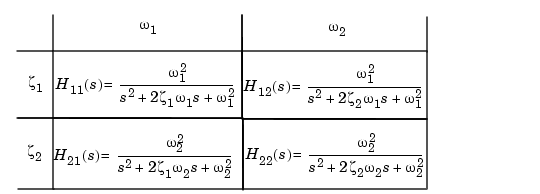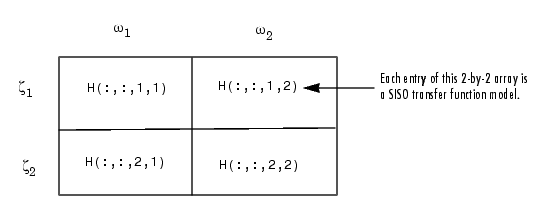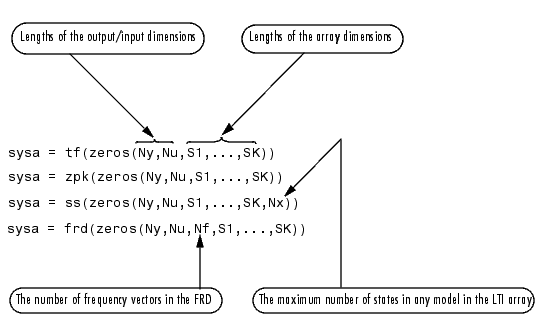

| Creating and Manipulating Models |   |
Building LTI Arrays Using for Loops
Consider the following second-order SISO transfer function that depends on two parameters,  and
and 

Suppose, based on measured input and output data, you estimate confidence intervals  , and
, and  for each of the parameters,
for each of the parameters,  and
and  . All of the possible combinations of the confidence limits for these model parameter values give rise to a set of four SISO models.
. All of the possible combinations of the confidence limits for these model parameter values give rise to a set of four SISO models.

Figure 4-6: Four LTI Models Depending on Two Parameters
You can arrange these four models in a 2-by-2 array of SISO transfer functions called H.

Here, for  ,
,  represents the transfer function
represents the transfer function

corresponding to the parameter values  and
and  .
.
The first two colon indices ( ) select all I/O channels from the I/O dimensions of
) select all I/O channels from the I/O dimensions of H. The third index of H refers to the first array dimension ( ), while the fourth index is for the second array dimension (
), while the fourth index is for the second array dimension ( ).
).
Suppose the limits of the ranges of values for  and
and  are [0.66,0.76] and [1.2,1.5], respectively. Enter these at the command line.
are [0.66,0.76] and [1.2,1.5], respectively. Enter these at the command line.
Since the four models have the same parametric structure, it's convenient to use two nested for loops to construct the LTI array.
H now contains the four models in a 2-by-2 array. For example, to display the transfer function in the (1,2) position of the array, type
For the purposes of efficient computation, you can initialize an LTI array to zero, and then reassign the entire array to the values you want to specify. The general syntax for zero assignment of LTI arrays is

To initialize H in the above example to zero, type
before you implement the nested for loops.
 | Generating LTI Arrays Using rss | Building LTI Arrays Using the stack Function |  |